Serving 1,017 students in grades Prekindergarten-8, Beasley Elementary Magnet Academic Center ranks in the bottom 50% of all schools in Illinois for overall test scores (math proficiency is bottom 50%, and reading proficiency is bottom 50%).
The percentage of students achieving proficiency in math is 6-9% (which is lower than the Illinois state average of 28%). The percentage of students achieving proficiency in reading/language arts is 16% (which is lower than the Illinois state average of 30%).
The student:teacher ratio of 15:1 is higher than the Illinois state level of 13:1.
Quick Stats (2025)
- School Type: Magnet School
- Grades: Prekindergarten-8
- Enrollment: 1,017 students
- Student:Teacher Ratio: 15:1
- Overall Testing Rank: Bottom 50% in IL
- Math Proficiency: 6-9% (Btm 50%)
- Reading Proficiency: 16% (Btm 50%)
- Science Proficiency: 20-24% (Btm 50%)
- Source: National Center for Education Statistics (NCES), IL Dept. of Education
Top Rankings
Beasley Elementary Magnet Academic Center ranks among the top 20% of public schools in Illinois for:
Category
Attribute
Percent Eligible For Free Lunch
School Overview
Beasley Elementary Magnet Academic Center's student population of 1,017 students has stayed relatively flat over five school years.
The teacher population of 67 teachers has grown by 11% over five school years.
School Type
Grades Offered
Grades Prekindergarten-8
Total Students
1,017 students
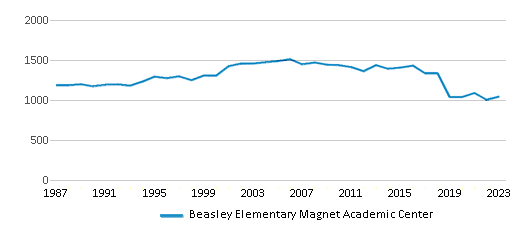
Gender %

Total Classroom Teachers
67 teachers
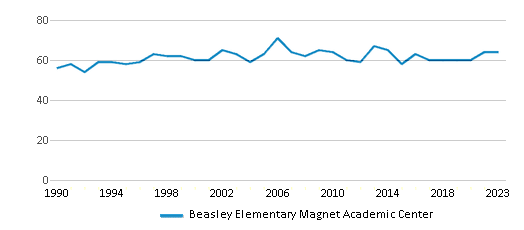
Students by Grade

School Rankings
Beasley Elementary Magnet Academic Center ranks within the bottom 50% of all 3,426 schools in Illinois (based off of combined math and reading proficiency testing data).
The diversity score of Beasley Elementary Magnet Academic Center is 0.06, which is less than the diversity score at state average of 0.70. The school's diversity has stayed relatively flat over five school years.
Overall Testing Rank
#2725 out of 3426 schools
(Bottom 50%)
(Bottom 50%)
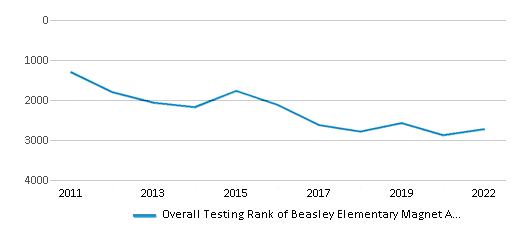
Math Test Scores (% Proficient)
(20-21)6-9%
28%
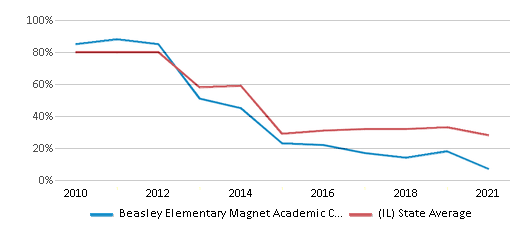
Reading/Language Arts Test Scores (% Proficient)
16%
30%
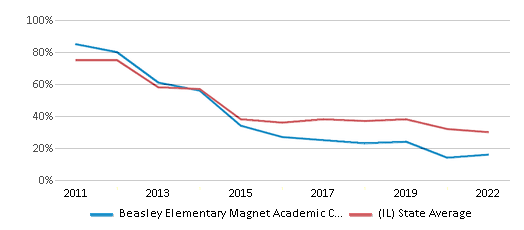
Science Test Scores (% Proficient)
20-24%
50%
Student : Teacher Ratio
15:1
13:1

American Indian
n/a
1%
Asian
n/a
6%
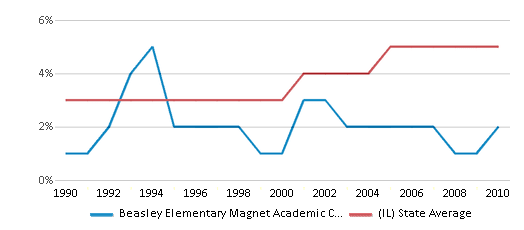
Hispanic
2%
28%
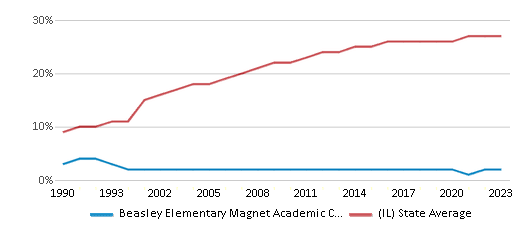
Black
97%
16%
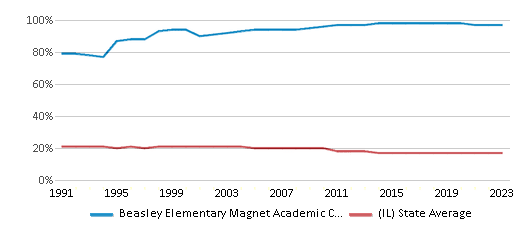
White
n/a
45%
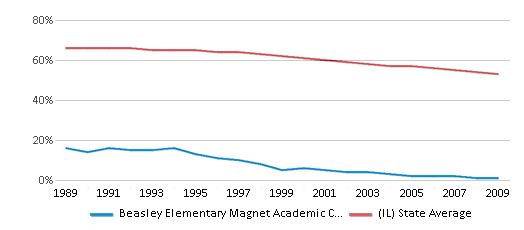
Hawaiian
n/a
n/a
Two or more races
1%
4%
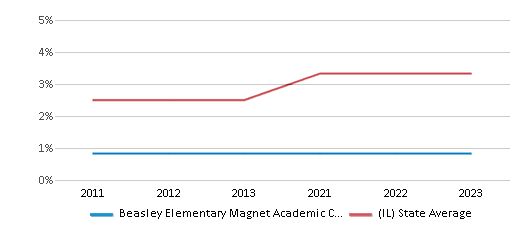
All Ethnic Groups
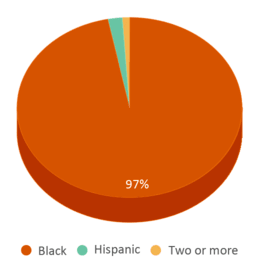

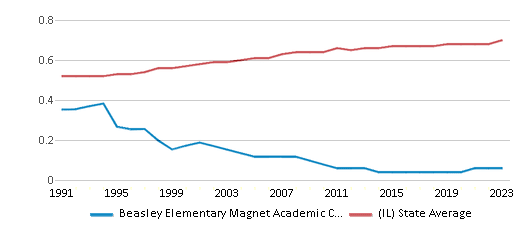
Eligible for Free Lunch
100%
43%

Eligible for Reduced Lunch (12-13)
4%
5%
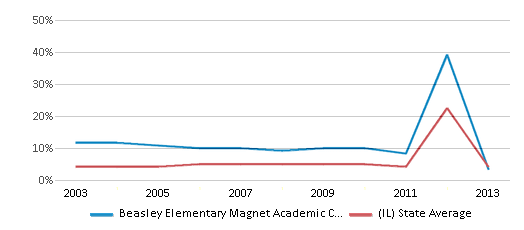
School Statewide Testing
School District Name
Source: National Center for Education Statistics (NCES), IL Dept. of Education
Profile last updated: 02/09/2025
Frequently Asked Questions
What is Beasley Elementary Magnet Academic Center's ranking?
Beasley Elementary Magnet Academic Center is ranked #2725 out of 3,426 schools, which ranks it among the bottom 50% of public schools in Illinois.
What percent of students have achieved state testing proficiency in math and reading?
6-9% of students have achieved math proficiency (compared to the 28% IL state average), while 16% of students have achieved reading proficiency (compared to the 30% IL state average).
How many students attend Beasley Elementary Magnet Academic Center?
1,017 students attend Beasley Elementary Magnet Academic Center.
What is the racial composition of the student body?
97% of Beasley Elementary Magnet Academic Center students are Black, 2% of students are Hispanic, and 1% of students are Two or more races.
What is the student:teacher ratio of Beasley Elementary Magnet Academic Center?
Beasley Elementary Magnet Academic Center has a student ration of 15:1, which is higher than the Illinois state average of 13:1.
What grades does Beasley Elementary Magnet Academic Center offer ?
Beasley Elementary Magnet Academic Center offers enrollment in grades Prekindergarten-8
What school district is Beasley Elementary Magnet Academic Center part of?
Beasley Elementary Magnet Academic Center is part of Chicago Public Schools Dist 299 School District.
In what neighborhood is Beasley Elementary Magnet Academic Center located?
Beasley Elementary Magnet Academic Center is located in the Washington Park neighborhood of Chicago, IL. There are 4 other public schools located in Washington Park.
School Calendar
View the Beasley Elementary Magnet Academic Center yearly calendar below. Note key dates such as:
Event
Date
Spring Break
March 24, 2025 (Monday)
School Reviews
3 1/20/2020
My daughter is a first-year student in the 6th grade gifted class at Beasley. We love the sense of pride the school members in here. She is challenged academically, gets a great dose of a black girl magic, and fits in the values of my family.
2 2/7/2008
There are entirely too many children in the school for it to be a magnet school. The focus is more on discipline than anything else. They have no control whatsoever. A lot of the teachers need to be evaluated and retested and they need a real principal. I know that it is a tough job and commend those who do it but don't just put a warm body in that spot and think that it is ok. Constantly squeezing 32 kids in the small classrooms and then they can't get what they really need is not good.
Review Beasley Elementary Magnet Academic Center. Reviews should be a few sentences in length. Please include any comments on:
- Quality of academic programs, teachers, and facilities
- Availability of music, art, sports and other extracurricular activities
Recent Articles

What Is A Charter School?
Explore the world of charter schools in this comprehensive guide. Learn about their history, how they operate, and the pros and cons of this educational innovation. Discover key facts about charter schools, including admission policies, demographics, and funding, as well as what to look for when considering a charter school for your child.

10 Reasons Why High School Sports Benefit Students
Discover the 10 compelling reasons why high school sports are beneficial for students. This comprehensive article explores how athletics enhance academic performance, foster personal growth, and develop crucial life skills. From improved fitness and time management to leadership development and community representation, learn why participating in high school sports can be a game-changer for students' overall success and well-being.

February 05, 2025
Understanding the U.S. Department of Education: Structure, Impact, and EvolutionWe explore how the Department of Education shapes American education, from its cabinet-level leadership to its impact on millions of students, written for general audiences seeking clarity on this vital institution.





